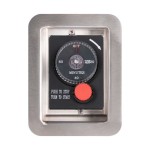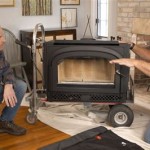Fireplace Grate Blowers: Enhancing Fireplace Efficiency
Fireplace grate blowers are increasingly popular accessories designed to improve the efficiency and heating capabilities of traditional wood-burning fireplaces. By circulating heated air from the firebox into the room, these devices can significantly enhance the heat output compared to relying solely on radiant heat. Understanding how these blowers work, their benefits, and the factors to consider when selecting one is crucial for optimizing fireplace performance.
The primary function of a fireplace is to provide supplemental heat, ambiance, and a focal point within a living space. However, a significant portion of the heat generated by a typical fireplace is often lost up the chimney. This inefficiency arises because natural convection relies on the heated air rising, drawing cooler air into the fireplace at floor level. While some radiant heat is emitted directly from the fire, a substantial amount of heat energy remains trapped or escapes without effectively warming the room.
Fireplace grate blowers address this issue by forcibly circulating the air within the firebox. These blowers are typically integrated into a specially designed grate or placed beneath the existing grate. The blower draws cooler air from the room, passes it through the heated area near the fire, and expels the warmed air back into the room. This forced convection process increases the rate at which heat is transferred to the living space, thereby improving the overall efficiency of the fireplace.
The Mechanics of a Fireplace Grate Blower
A fireplace grate blower generally consists of two main components: the grate itself and the blower unit. The grate is usually constructed from heavy-duty steel or cast iron to withstand the high temperatures within the firebox. The design of the grate often incorporates channels or tubes through which the air is circulated. These channels maximize the surface area exposed to the heat, enhancing the heat transfer process.
The blower unit is typically a centrifugal or tangential fan powered by electricity. The blower unit is typically positioned beneath or behind the grate, though some models are integrated directly into the grate design. The blower draws air from the room, forces it through the channels within the grate, and then expels the heated air back into the room. Many models offer variable speed settings, allowing the user to control the airflow and heat output. The blower's power consumption is generally low, making it an energy-efficient way to improve fireplace performance.
The placement of the blower is critical for its proper operation. Positioning the blower too close to the fire could damage the unit, while positioning it too far away might reduce its effectiveness. Grate blowers should always be installed and used according to the manufacturer's instructions. This prevents damage to the unit and ensures safe and effective operation.
Benefits of Using a Fireplace Grate Blower
The most significant benefit of using a fireplace grate blower is increased heating efficiency. By circulating heated air, these devices can significantly improve the amount of usable heat delivered to the room. This allows the fireplace to heat the space more effectively, reducing reliance on central heating systems and potentially lowering energy costs.
Another benefit is that a fireplace grate blower can help to distribute heat more evenly throughout the room. Radiant heat from a fireplace tends to concentrate near the fire, leaving other areas of the room cooler. By circulating the air, the blower helps to mix the warm air with the cooler air, creating a more consistent temperature throughout the space. This makes the room more comfortable and reduces temperature fluctuations.
Improved air quality is yet another advantage. Fireplaces, especially older models, can sometimes contribute to indoor air pollution by releasing smoke and particulates into the room. A fireplace grate blower, particularly when used in conjunction with a properly maintained chimney and flue, can improve air circulation and help to vent smoke and pollutants out of the room more effectively. This is particularly important for individuals with respiratory sensitivities or allergies.
Factors to Consider When Choosing a Fireplace Grate Blower
Several factors should be considered when selecting a fireplace grate blower. The size of the fireplace is a primary consideration. The grate blower must be appropriately sized to fit within the firebox without obstructing the fire or impeding airflow. It is essential to measure the firebox dimensions carefully before purchasing a grate blower.
The blower's airflow capacity, measured in cubic feet per minute (CFM), is another important consideration. A higher CFM rating indicates that the blower can move more air, which can translate to greater heat output, however, it might also increase the noise level. The appropriate CFM rating will depend on the size of the room and the desired level of heating. Finding a balance between air flow and noise is usually a factor.
The material and construction quality of the grate and blower unit is also crucial. The grate should be made from durable materials that can withstand high temperatures without warping or corroding. The blower unit should be well-built and designed for reliable performance. Look for models with robust motors and durable housings to ensure longevity.
Noise level is another consideration for many users. Some blower units can be quite loud, which can be disruptive or annoying. Look for models with noise reduction features or variable speed settings, which allow you to adjust the airflow and noise level to your liking. Reading customer reviews can often provide valuable insights into the noise levels of different models.
Lastly, consider the ease of installation and operation. Some grate blowers are designed for easy installation, while others may require professional assistance. Choose a model that you are comfortable installing and operating. Look for features such as variable speed controls and automatic shut-off functions for added convenience and safety.
In conclusion, fireplace grate blowers can significantly enhance the efficiency and heating capabilities of wood-burning fireplaces. By understanding the mechanics, benefits, and factors to consider when selecting a blower, homeowners can optimize their fireplace performance and improve the comfort and warmth of their living spaces.

Grate Heater Wikipedia

Medium Double Row Tube Fireplace Grate Heater With Dual Blowers Hastyheat

Choose A Fireplace Grate Heater From The 3 Top Ing For 2024
Fireplace Heater 5 Tube W Blower

Tube Fireplace Grate Heater For Zc Fireplaces

5 Tube Grate Heater Wood Burning Fireplaces

Spitfire Tube Fireplace Heaters Heater Blower Heating And Plumbing

4 Tube Grate Heater Wood Burning Fireplaces

Fireplace Screen Decor Grate Heater

Grate Heater With Masonry Fireplace Doors Customized
Related Posts








